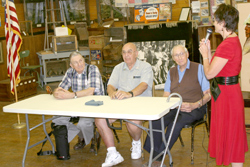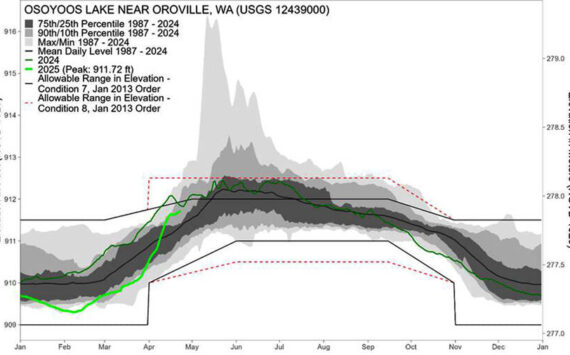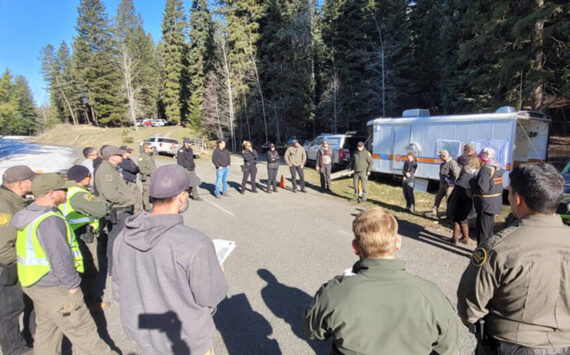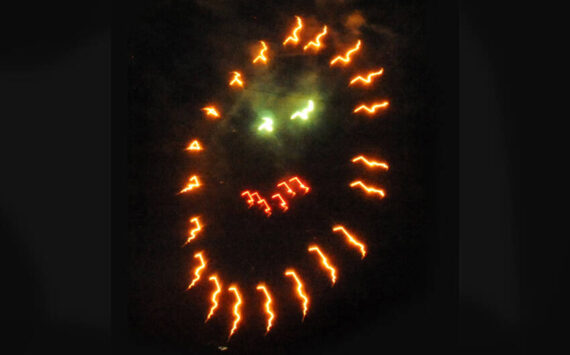
Photo by Gary DeVon Okanogan Borderlands Historical Society President Kay Sibley asked Ralph Patterson, Clayton Emry and Web Hallauer the question, “What was Main Street like when you first saw it?”
What was Oroville’s Main Street like when you first came here? was the question put to three guests of the Oroville Chamber of Commerce in a meeting held at the old depot last week.
The question was posed by Kay Sibley, president of the Okanogan Borderlands Historical Society, which hosted the chamber of commerce meeting. The special guests for the meeting were Web Hallauer, Clayton Emry and Ralph Patterson.
Hallauer said Oroville came on his “screen” in 1931, just after graduating from high school in Yakima. His family had always been in the dried fruit business and they moved out west after their business in southeastern part of the country succumbed to the Depression.
“The whole family moved by train from Rochester, New York,” he said.
They ended up in Selah near Yakima and started building fruit dryers, having one in Prosser and another one in Wenatchee where Hallauer worked when he was in high school. .
In 1936, following college, Hallauer was put in charge of the little drying plant his dad had bought in Oroville.
“I arrived in town around midnight and stayed at the Peerless. My living quarters were supposed to be vacated, but the family that was living there named Black couldn’t vacate,” Hallauer said.
He was earning $35 a week and said he’d cash his check at Mother Prince’s store. “At that time you’d get $30 Canadian and $5 American,” he said.
In the 1940s the dryer plant doubled in size to meet the demand and in 1941 it re-doubled in size because it had been declared necessary for the war effort.
“The government was buying every bit of fruit the plant could dry, he said.
“One year I bought one million boxes of apples from Canada… so an extra million went through the plant,” said Hallauer.
In the 1950s he said the business went up and down and in 1958 it was very bad because the Wenatchee factory burned down.
“During the Berlin blockade we got a call asking us how fast we could make potato flour. The government had a lot of potatoes on hand and when we went into production we were heads over heels in debt… we hadn’t been able to service our customers.”
When the Russians blockaded the German city the plant went into full production. “I think that was the biggest payroll in town,” he said. “I feel pretty good about what we did during those years at the old Valley Evaporating Plant.”
Hallauer later became a Washington State Senator and was the state’s first director of the Department of Ecology after being appointed by then governor Dixie Lee Ray.
Emery came with his family from Nebraska in 1935 when he was he was still a youngster. His family owned an apple orchard. After college and military service Emery needed a job and felt farming was “scary in the winter.” He took his uncle’s advice and applied for a job as a bookkeeper at Oroville State Bank, admitting to those at the meeting he didn’t know anything about bookkeeping. He later worked his way up to teller and eventually approved loans and then became a vice president. In 1960 he and his brother bought and operated the Oroville Weekly Gazette for a number of years.
Later he and his wife Joyce opened the Montgomery Wards store in town, then Mid-Valley Bank asked him if he wanted to come work for them.
About Oroville when he first saw it, Emery said, “I didn’t even know there was a lake here for about the first four years. We lived on the old highway south of town and only came into town on Sunday for church and to go to school or to get groceries,” he said.
Emry said he had a connection with Hallauer’s Valley Evap that he might not know about. It was a quilt featuring the names of employees at the plant that was quilted by Emry’s mother-in-law.
“Joanne Whitaker was in Idaho when she saw the quilt and the owner of the shop said if you recognize any of these names you can have it. She recognized several and brought the quilt back to town,” said Emry.
The quilt is now part of the museum’s collection.
Ralph Patterson first came to Oroville in the late 1950s after a salesman in Moses Lake, where he was from, recommended the area as a place to build an A&W franchise.
“I wasn’t originally going to go to Oroville, I was going to look on the coast but this salesman said I should go check it out,” said Patterson. “When I first saw the place I thought ‘My God, there’s nothing here!’ and I went back to Moses Lake and that salesman kept telling me ‘Go to Oroville, Go to Oroville.'”
Patterson did end up going to Oroville, building his restaurant in 1959 where the Oroville Family Medical building is now.
“I’ve been very happy here,” Patterson said about his nearly 50 years in town.






